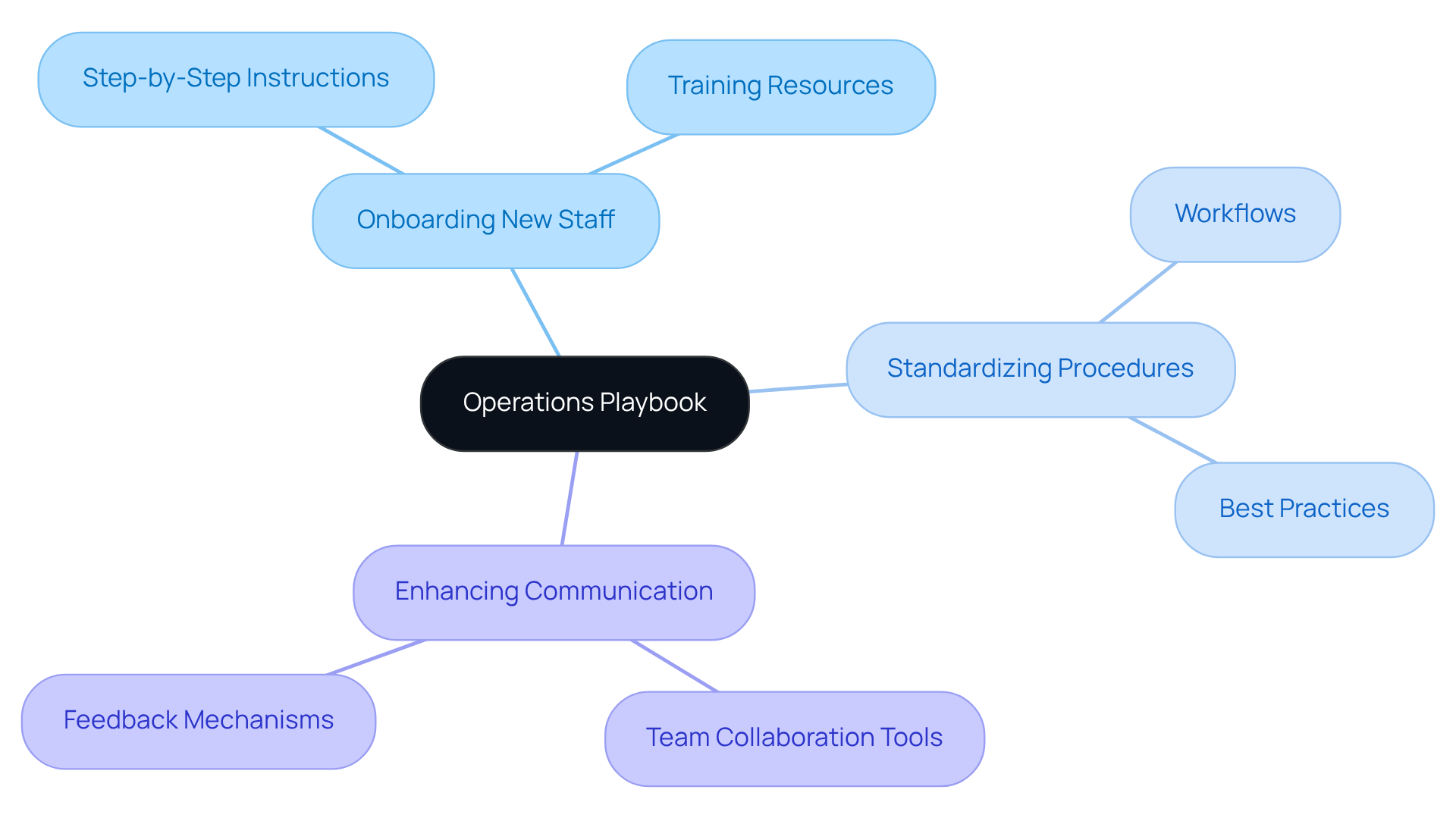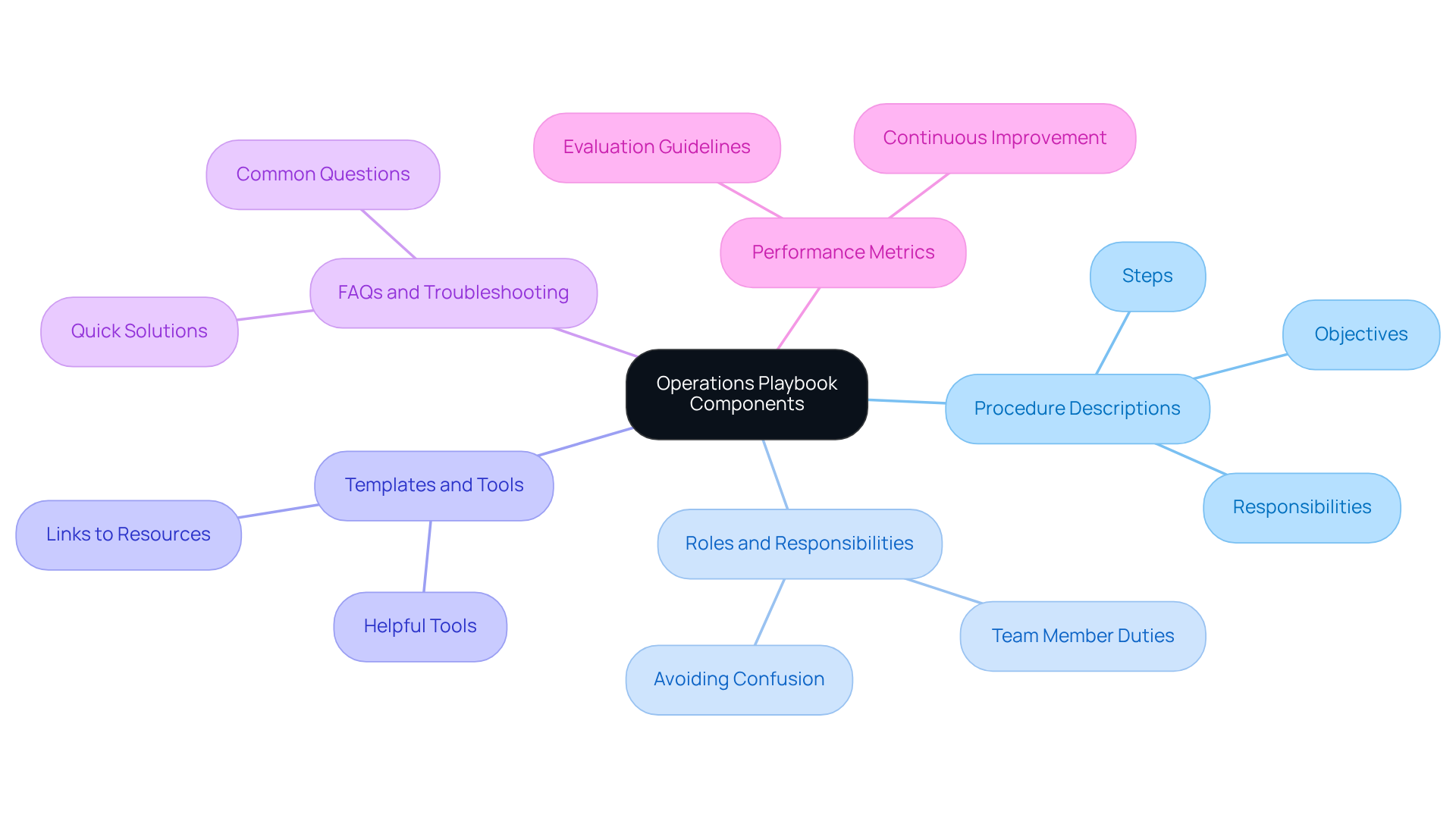
Knowledge Management through Documentation
|
October 17, 2025
|
Create an Effective Operations Playbook Template for Your Team
Overview
You might be wondering how to create an effective operations playbook template for your team. Well, it all starts with defining its purpose! Key components include:
- Procedure descriptions
- Performance metrics
But don’t forget to customize it to reflect your organization's unique culture. Speaking of culture, collaboration across departments is crucial.
Establishing a regular update process ensures that your playbook remains relevant and effective. This not only enhances team communication but also boosts operational efficiency.
So, let’s dive into how you can make this work for your team!
Key Highlights:
- The operations playbook serves purposes such as onboarding, standardising procedures, and enhancing team communication.
- Defining the scope of the playbook is crucial, including which divisions to cover and the level of detail required.
- Key components of an effective playbook include procedure descriptions, roles and responsibilities, templates, FAQs, and performance metrics.
- Customising the template to reflect the organisation's culture, branding, and processes enhances engagement and operational efficiency.
- Involving team members from various departments ensures diverse perspectives and expertise in the playbook.
- Establishing a process for regular updates and maintenance is essential for keeping the manual relevant and effective.
- Feedback mechanisms allow for continuous improvement and ensure accurate operational guidance.
Introduction
Creating an operations playbook isn’t just about putting together a bunch of procedures; it’s really about building a crucial framework that can boost your team’s efficiency and communication. You might be wondering, what makes an operations playbook effective? This article dives into the key components of a solid operations playbook template, helping organizations tailor their manuals to fit their unique processes and cultures. But here’s the kicker: as teams aim for clarity and consistency, how can they keep their playbook fresh and engaging over time? Now, let’s explore that together!
Define the Purpose and Scope of Your Operations Playbook
Creating an effective operations manual? Let’s start with the basics: What’s the purpose of this operations playbook template? You might be wondering if it’s for onboarding new staff, standardizing procedures, or maybe even enhancing communication within your teams. With SowFlow's instant documentation solution, you can easily whip up user guides that tackle these needs head-on.
Once you’ve nailed down the purpose, it’s time to outline the scope. This means figuring out which divisions or activities to include and how detailed you want to get. For instance, if your manual is aimed at onboarding, you’ll want to include step-by-step instructions for new employees. On the flip side, a guide focused on process standardization might zoom in on workflows and best practices.
By leveraging SowFlow's features to update and revise your documentation with ease, you’ll ensure that your guide remains focused and relevant. This not only boosts usability but also enhances its effectiveness. So, are you ready to dive in and make your operations manual a game-changer with an operations playbook template?

Identify Key Components to Include in the Playbook
You might be wondering what makes an effective operations playbook template. Well, it should definitely include a few key components! First up, Procedure Descriptions: these are detailed explanations of each procedure, covering objectives, steps, and who’s responsible for what. Next, we have Roles and Responsibilities: it’s super important to clearly define what each team member is doing to avoid any confusion down the line.
Now, let’s talk about Templates and Tools: make sure to include links to any templates or tools that can help with the procedures. And don’t forget about FAQs and Troubleshooting: having a section that addresses common questions and issues will provide quick solutions when things get tricky. Finally, you’ll want to include Performance Metrics: these guidelines will help you evaluate how effective each procedure is, ensuring there’s always room for improvement.
By weaving these elements together, your guide becomes a go-to resource that teams can rely on for direction and support. So, are you ready to dive into creating your very own operations playbook template?

Customize the Template to Align with Organizational Needs
To make your operations manual really work for you, it’s important to customize the template to reflect your organization’s unique culture and processes. You might be wondering how to start? Begin by adding your company’s branding elements—think logos and color schemes! This not only boosts visual appeal but also fosters a sense of ownership among your staff, making the guide feel more engaging and connected to your organization. Plus, having a recorded guide gives new members clear direction from day one, which is key for their smooth integration.
Now, let’s talk about language and tone. You’ll want to adapt these to match your organizational style—whether that’s formal or informal. This alignment helps create a relatable document that resonates with employees, increasing their engagement with the content. Also, don’t forget to include specific workflows and processes that are unique to your organization. For instance, if your team uses certain software tools, make sure to include references and guides for those within the manual. This tailored approach not only enhances relatability but also encourages team members to actively engage with the guidelines, ultimately leading to better operational efficiency and clarity.
Moreover, crafting the strategy document should be a team effort! Involve members from different departments—like sales, marketing, and HR. This collaboration ensures that the guide captures diverse perspectives and expertise, making it a more comprehensive resource. By keeping an eye on common pitfalls in customizing an operations guide—like forgetting to involve key stakeholders or neglecting to regularly update the content—you can sidestep missteps and boost the guide's effectiveness. In the end, tailoring your operations guide can lead to greater employee involvement and a more streamlined operational system.

Establish a Process for Regular Updates and Maintenance
To keep your operations manual effective, you might be wondering how to set up a clear process for regular updates and maintenance. It’s a good idea to assign a group or person who will be accountable for checking the guide at specific intervals—like quarterly or bi-annually. During these reviews, take a moment to assess how relevant the content is, spot any outdated information, and gather feedback from users.
Speaking of feedback, it’s also helpful to have a system in place for your colleagues to propose updates or report errors as they come up. This proactive approach not only keeps your playbook current but also nurtures a culture of continuous improvement within your organization. Plus, it ensures that everyone on the team has access to the most accurate and effective operational guidance.

Conclusion
Creating an effective operations playbook template is crucial for boosting your organization's efficiency and clarity. You might be wondering how to get started. By clearly defining its purpose and scope, identifying key components, and customizing the content to fit your unique needs, you can develop a comprehensive resource that guides your team through various processes and procedures. This strategic approach not only streamlines operations but also nurtures a culture of collaboration and continuous improvement.
Now, let’s dive into what to include! The article points out the importance of:
- Detailed procedure descriptions
- Roles and responsibilities
- Templates
- FAQs
- Performance metrics
in the playbook. Customizing the template to align with your organization's culture and processes is essential—after all, it needs to resonate with your employees. Plus, establishing a process for regular updates and maintenance is key to keeping the playbook relevant and effective, ultimately enhancing operational efficiency.
In summary, think of an operations playbook as more than just a manual; it’s a vital tool that can significantly impact your team’s performance and communication. So, organizations are encouraged to invest the time and resources needed to create, customize, and maintain their operations playbook. By doing this, you empower your teams to navigate challenges effectively and contribute to a more organized and productive work environment. Sounds like a plan, right?
Frequently Asked Questions
What is the purpose of an operations playbook?
The purpose of an operations playbook is to serve various needs such as onboarding new staff, standardizing procedures, and enhancing communication within teams.
How do I determine the scope of my operations playbook?
To determine the scope, identify which divisions or activities to include and decide how detailed the content should be. For example, an onboarding manual would require step-by-step instructions, while a guide for process standardization would focus on workflows and best practices.
How can SowFlow assist in creating an operations playbook?
SowFlow provides an instant documentation solution that allows users to easily create user guides tailored to specific needs, update, and revise documentation to keep it focused and relevant.
What are the benefits of keeping the operations manual updated?
Keeping the operations manual updated boosts usability and enhances its effectiveness, ensuring that the guide remains relevant for its intended purpose.
👍
What others are liking
5 Steps to outline your ideal documentation structure
5 MINS READ
Where to start the your journey of mapping out your ideal documentation structure, aligning it with the very heartbeat of your organization?
Defining a winning level of detail in your process
3 MINS READ
What is too much detail, and what is too little? This article described in that winning level detail about what detail is enough.





